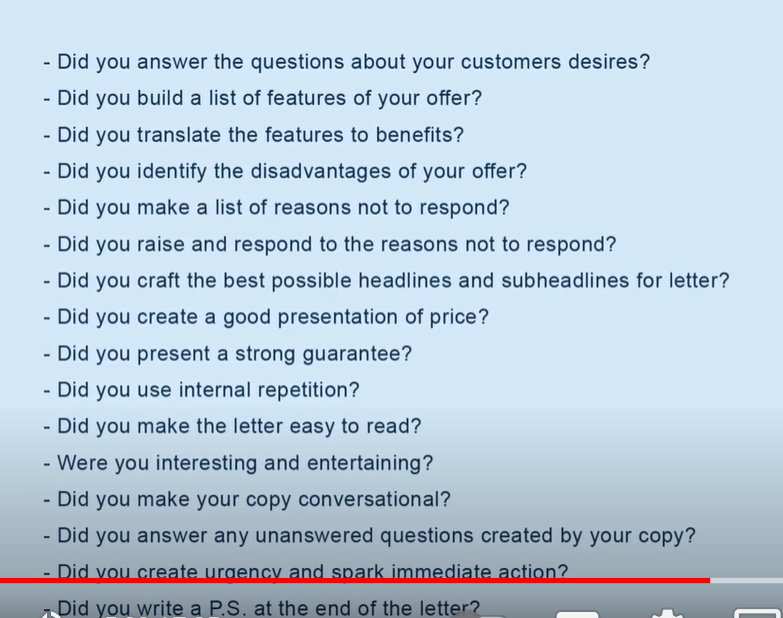Wouldn’t you just love to acquire skills that get you writing sales letters that convert like crazy? It’s not hard. It’s mostly formulaic. Except for creatively coming up with the ‘hook’ and the story. This YouTube video shows you the process:
For how to write a sales page that converts, start here
The above video is brief: 2:52 minutes, and introduces you to the idea of copywriting triggers, and Ultra-Quick Writing Prompts. It adds that as children, we already had the persuasive speaking skills that we require as copywriters.
What exactly is this profession all about?
What is Copywriting?
Copywriting is the art and science of turning words into profits. It requires a methodical, step-by-step approach. Researching your audience comes first. Relax in your chair.
Understand The Desires of The Customer
Dan Kennedy asks, “What keeps them awake at night?” “What are their daily top 3 frustrations?” And, “what do they secretly desire most?” You enter the conversation that the customer is already having in his/her head!
You will want to align with the desire or the goal that your customer is already focused on. What are they dreaming of having?
Explain Your Offer
Write a list of your product’s features and benefits. People buy things for what they do for them. How they’ll feel relieved, less fearful, less tense. Save time, effort and money, etc.
Address any flaws openly
By being upfront and honest about a product’s shortcomings, we are forced to address the client’s fears, questions and concerns. Write an FAQ section. This will help you to create trust and credibility.
Hold Attention to Get The Letter Read
Flag the reader method: “Embarrassing belly bulge? Guaranteed weight loss up to 15lbs in 15 days… with no exercise!”
Hold the attention with sub heads and bold words. Writing sales letters successfully involves riveting the prospective customer’s attention – interest – desire mechanism.
Price Minimizer Strategies
Use the problem, agitation, solution method. Demonstrate with facts and statistics. First, we stir up an emotional response to the problem. Later, we position our product as the only real solution to the problem.
Second strategy: Winners versus losers, by Dan Kennedy. Tell a brief story of two neighbors seeding their lawns, or doing a home improvement. One works out perfectly. That’s the model to follow, isn’t it?
Motivate Action. CTA.
Mention that a limited quantity is available: “Only 100 items made.” Introduce time urgency. A deadline or a countdown timer is ticking. “The 50% off sale ends in 2 hours.”
Write the first draft of the sales letter
Writing sales letters does require a lot of editing and rewriting! But don’t do it at first. Get all the persuasive ideas written down first.
Rewrite to improve strategy
Introduce internal repetition, to re-state your message in various ways. For example, in a story, in a straightforward way, and in an example, and a testimonial. In a quote from an expert, and in a numbered summary. This is sheer genius.
Rewrite for Style and Readability
Writing sales letters is best with short sentences and paragraphs. Lots of white space. It is easier to read and to digest.
Answering Questions and Objections
Use frequently asked questions, or F.A.Q. This is an effective way to dissolve resistance. Use direct answers, testimonials, case studies and restatements of your guarantee.
Spark immediate action – CTA Triggers
- limited availability
- multiple, irresistible bonuses
- deadlines
- discounts for fast response
- penalties for slow response
The P.S. Section at the end
Use the P.S. to summarize your offer. Many readers skip straight to the bottom of a sales page. Summarize and use a sense of urgency.
Dan Kennedy Checklist Guide:

Aggressive, Heavy Editing of The Sales Letter
Cut out everything that fails to advance, strengthen or reinforce the main story.
The Final Review
Review your incredible sales letter one last time.
Publishing and Retargeting
Most new marketers fail to do retargeting. Follow up. You will need to contact people who have shown an interest in your offer. Retarget on social media platforms and on search engines.
Test Everything!
Test headlines, body copy, colors, offers, and calls-to-action. Absolutely everything can be tested. Incremental improvements are always waiting for you. Build a file bank (or database) of what works best for you and your customers.
I have really enjoyed sharing Dan Kennedy’s copywriting tips with you today!
Geoff Dodd, Editor in Chief, Online Course Business School, NZ.

